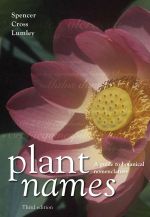BOOK REVIEWS
By Roger Spencer, Rob Cross, and
Peter Lumley Reviewed by Andrew Maloy Sixteen years ago I purchased the second edition of Plant Names: A guide to botanical nomenclature by Peter Lumley and Roger Spencer of the Royal Botanic Gardens, Melbourne and, until this third version appeared, it sat on a bookshelf within easy reach of my desk and was a book I often referred to. As a plain English guide to the use of plant names and how to write them correctly it was the best I had come across. Now there is the improved version, this third edition, with 162 pages compared to the previous 54 and many colour photos, tables, diagrams and drawings to explain and illustrate the text. Botanical names can be daunting but in this relatively easy to follow book the authors work their way through the reasons for using botanical names, the conventions for writing them according to the relevant international codes of nomenclature and almost every question that could be asked about the whys and wherefores and rights and wrongs of plants names is, I believe, answered in this book. The book is divided into four parts. The first relates to Wild Plants, describing how and why the binomial system using Latin names became the internationally accepted way of naming plants. The International Code of Botanical Nomenclature is explained along with the nested hierarchy of ranks and taxa, orders, families, genera, species, subspecies, varieties, forms and natural hybrids. Name changes, type specimens, describing new species and reclassifying species are also covered. The text becomes a little heavy going in some places here but can be justified for the sake of accuracy. Part two covers Cultivated Plants and Cultigens and in doing so gets down to the nitty-gritty of plant names as most gardeners know them – our gardens are full of human-altered plants. The International Code of Nomenclature for Cultivated Plants is explained along with the terms cultigen and cultivar and all their ramifications. A chapter on Marketing Names (trade designations) describes how plant labels are an important component of plant marketing and looks at the issues of trade designations, trademarks and plant breeder’s rights in the commercial reality of plant marketing. In their attention to detail the authors also include gene patenting and genetic engineering in the discussion. Part three is entitled Using Plant Names. Clear, easy to follow examples show how to write plant names correctly, followed by a chapter on how to pronounce botanical names. Then there is a very short, but extremely useful chapter, Recommended Format for Nursery Plant Labels, which commences by saying “Plant labels in retail nurseries now carry a plethora of names of uncertain botanical and legal status that are as confusing to industry employees as they are to the general public”. The authors proceed to identify issues and recommend ways to ensure retail plant labels are accurate and not misleading or deceptive. Part four, Plant Name Resources, consists of a wealth of references to help the reader with finding and checking plant names. Books and websites are listed, along with floras and checklists of currently accepted plant names from around the globe, International Cultivar Registration Authorities (including the RNZIH for Coprosma, Hebe, Heliohebe, Phormium and Pittosporum) and many other useful resources. One very minor criticism I have of this fine piece of work is that while illustrated with beautiful photos many of them have no captions, leaving the reader wondering “what is that gorgeous plant?” or “where was that photo taken?” All in all this is a book I am sure will, like its predecessor, stand the test of time and is an ideal text for those to whom a good understanding of and the correct use of plant names is important. |
Home | Journal
| Newsletter | Conferences
Awards | Join
RNZIH | RNZIH Directory | Links
© 2000–2026 Royal New Zealand Institute of Horticulture
Last updated: March 1, 2021


 Plant Names:
Plant Names: